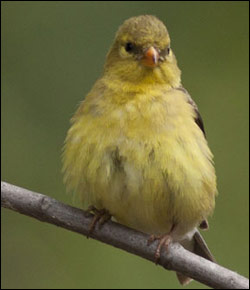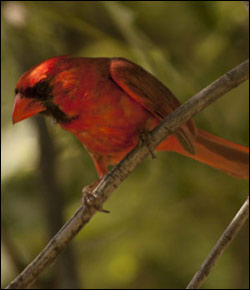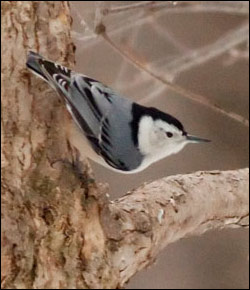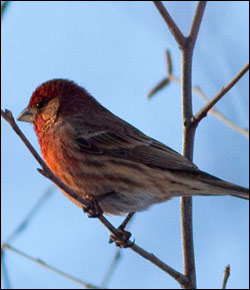Kaukauna Is Proud to Be a Bird City
Bird City Wisconsin has selected the City of Kaukauna as an official Bird City, recognizing our efforts to celebrate and conserve our wonderful and diverse bird population. 1000 Islands Environmental Center played an instrumental role in achieving this recognition. The application highlights can be viewed here.
BIRD CITY
“Making our communities healthy for birds…and people”
by Debbie Nowak
 As an Environmental Center we are constantly striving to spread awareness of environmental issues in hopes that we can inspire others to take action in their daily lives that will make a positive impact on the environment around us. One way that we have been able to celebrate the great work that we do together as a community is through our Bird City, Wisconsin certification.
As an Environmental Center we are constantly striving to spread awareness of environmental issues in hopes that we can inspire others to take action in their daily lives that will make a positive impact on the environment around us. One way that we have been able to celebrate the great work that we do together as a community is through our Bird City, Wisconsin certification.
The Bird City Wisconsin program began back in 2009 through the Wisconsin Bird Conservation Initiative. The program has grown greatly in the years since with 96 communities in the state now being recognized for their bird conservation efforts. I am proud to announce that Kaukauna is now one of those communities.
What is a Bird City? In short, a Bird City is a community that makes conscious efforts that benefit bird populations. The focus of Bird City is to encourage communities to become proactive in bird conservation practices.
Why should we care about birds? There are so many reasons. The most obvious for 1000 Islands is because they are an important part of the ecosystem and you can tell a lot about the health of the ecosystem by the birds it supports. Remember the stories of how miners would bring canaries into the coal mines? Birds can be very sensitive to changes in the environment. Just as those canaries warned of trouble in the mines, our wild populations can warn us of trouble in the environment. Rachel Carson, well known writer, scientist, and ecologist published a book titled Silent Spring after receiving a letter from a concerned citizen about many birds dying after the use of DDT. That one observation and subsequent book started a movement against the use of DDT, eventually resulting in the banning of the chemical.
 Birds are a great benefit to humans as well. Many birds help to control pest populations from mosquitoes and other harmful insects to mice, rats and other small rodents through their diet. I love to see swallows performing their acrobatic maneuvers in the air as they feed on insects. The community as a whole benefits from birds as well. Bird watchers have become a great tourism boost for many communities as birders often travel to areas with good viewing opportunities. When you create habitat that supports bird populations, you also attract people interested in seeing those birds which brings extra tourism dollars into the community.
Birds are a great benefit to humans as well. Many birds help to control pest populations from mosquitoes and other harmful insects to mice, rats and other small rodents through their diet. I love to see swallows performing their acrobatic maneuvers in the air as they feed on insects. The community as a whole benefits from birds as well. Bird watchers have become a great tourism boost for many communities as birders often travel to areas with good viewing opportunities. When you create habitat that supports bird populations, you also attract people interested in seeing those birds which brings extra tourism dollars into the community.
After a few years of discussion over how great it would be to make Kaukauna into a Bird City, we finally achieved it in 2015, and we are very proud of our efforts in bird conservation. In order to qualify as a Bird City, communities must prove that they meet at least 7 different criteria in four different categories including creation and protection of habitat, participation in programs promoting effective community forest management, limiting or removing hazards to birds, and public education.
The fact that we are fortunate enough to have the Environmental Center and 350 acres of conservancy zone here within the City makes big strides towards earning this title. 1000 Islands is zoned as conservancy giving the property protection from development and has been a focus of birding for a long time including participation in events such as the Christmas Bird Count. Designation as a Tree City, USA is also a requirement for applying for Bird City status. Here in Kaukauna, we have been a Tree City since 1994 demonstrating our commitment to proper urban tree management.
 One of the most fun criteria towards becoming a bird city is the requirement to hold a bird focused event. We achieve this through our annual Eagle Days program held every January. This is a great event that attracts people from all over the state to see the wintering eagle populations. Guided observations and guest speakers are brought in to round out a day of education highlighting our nation’s symbol. Each year we see around 1000 people came to take part in the Eagle Days festivities.
One of the most fun criteria towards becoming a bird city is the requirement to hold a bird focused event. We achieve this through our annual Eagle Days program held every January. This is a great event that attracts people from all over the state to see the wintering eagle populations. Guided observations and guest speakers are brought in to round out a day of education highlighting our nation’s symbol. Each year we see around 1000 people came to take part in the Eagle Days festivities.
New efforts towards bird conservation that have taken place because of our interest in a Bird City designation involve education on how residents within the city, and everywhere can make simple changes to help birds. Here are a few that you can try at home yourself:
Keep Cats Indoors
Free roaming cats present a big problem for bird populations. It is estimated that between 1.3 and 4 billion birds are killed each year by cats including both house cats that are allowed to roam outside and feral cats. The American Bird Conservancy has begun a program called Cats Indoors educating owners on the benefits of keeping their cats inside. I encourage everyone to read over the information and tips from the Cats Indoors program within this newsletter.
Prevent Bird Strikes
Windows can be dangerous for birds, either reflecting the outdoor space around them or creating the appearance of a tunnel if windows are positioned giving view from one side of the building to the other. When a bird mistakes what they see in the window for a safe flight path, the impact can kill them. Simple tips to prevent bird deaths from windows includes keeping feeders as close to your windows as possible so that if they do take off towards the window from the feeder they won’t have enough momentum to cause injury, closing your blinds and curtains to break up the appearance of a clear flight path and to move houseplants away from the window to lessen the chance of a bird trying to reach the plant as a place to perch. There are also special window clings that can be purchased at many bird feed stores, online and now at 1000 Islands. These window clings look like frosted glass on your window, but they reflect UV light from the sun which birds can see easily and acts as a stoplight.
 Create or Preserve Good Bird Habitat
Create or Preserve Good Bird Habitat
Creating good bird habitat can be as simple or involved as you want. Planting native plants around your house is a great way to provide habitat as well as great viewing opportunities. Check out the Wisconsin Department of Natural Resources page “Plant Native Plants to Help Nature” for great resources or contact your local Wild Ones chapter for advice. The Wild Ones chapter right here in the Fox Valley is always eager to help and even hosts native plant sales.
Not interested in landscaping or don’t have a yard to work with? Think simpler. Smart buying choices can support conservation efforts all over the world. The next time you buy coffee, look for the certified bird friendly symbol. Your average coffee is a variety that is grown in full sun, causing coffee growers to clear cut valuable tracts of rainforest in order to grow a successful crop. There are other varieties of coffee that grow best in the shade. This is referred to as shade grown coffee. Organic coffee is another option when you purchase coffee, verifying that few if any pesticides were used in the process. Bird Friendly coffee is the only certification that encompasses 100% pure shade grown and organic coffee resulting in the best habitat preservation in the coffee industry. Not only does that help conserve tropical bird populations, but it helps to provide essential wintering habitat to the many Wisconsin birds that spend their winters in Central and South America. The Smithsonian Migratory Bird Center maintains a list of coffee roasters that provide Bird Friendly coffee. Helping birds, never tasted so good!
Beyond the Bird Feeder: Creating a Bird Friendly Yard
Anytime is great time to reflect on the great accomplishments that all of us have made in the name of bird conservation already, but also a great time to look forward to what else we can do together as a community. Together, we can make our communities healthier for birds…and people!
